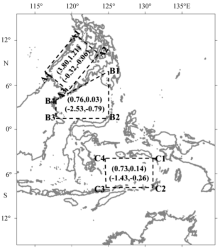| [1] |
滕飞, 2013. 印尼近海潮汐潮流的数值模拟[D]. 青岛: 国家海洋局第一海洋研究所.
|
|
TENG FEI, 2013. Numerical simulation of principal tidal constituents in the Indonesia Adjacent Seas[D]. Qingdao: The First Institute of Oceanography (in Chinese with English abstract).
|
| [2] |
ALTHAUS A M, KUNZE E, SANFORD T B, 2003. Internal tide radiation from Mendocino Escarpment[J]. Journal of Physical Oceanography, 33(7): 1510-1527.
|
| [3] |
BUIJSMAN M C, LEGG S, KLYMAK J, 2012. Double-ridge internal tide interference and its effect on dissipation in Luzon Strait[J]. Journal of Physical Oceanography, 42(8): 1337-1356.
|
| [4] |
BUIJSMAN M C, KLYMAK J M, LEGG S, et al, 2014. Three- dimensional double-ridge internal tide resonance in Luzon Strait[J]. Journal of Physical Oceanography, 44(3): 850-869.
|
| [5] |
CARTER G S, FRINGER O B, ZARON E D, 2012. Regional models of internal tides[J]. Oceanography, 25(2): 56-65.
|
| [6] |
CLEMENT A C, SEAGER R, MURTUGUDDE R, 2005. Why are there tropical warm pools?[J]. Journal of Climate, 18(24): 5294-5311.
|
| [7] |
EGBERT G D, BENNETT A F, FOREMAN M G G, 1994. TOPEX/POSEIDON tides estimated using a global inverse model[J]. Journal of Geophysical Research: Oceans, 99(C12): 24821-24852.
|
| [8] |
EGBERT G D, EROFEEVA S Y, 2002. Efficient inverse modeling of barotropic ocean tides[J]. Journal of Atmospheric and Oceanic Technology, 19(2): 183-204.
|
| [9] |
FFIELD A, GORDON A L, 1992. Vertical mixing in the Indonesian thermocline[J]. Journal of Physical Oceanography, 22(2): 184-195.
|
| [10] |
FFIELD A, GORDON A L, 1996. Tidal mixing signatures in the Indonesian Seas[J]. Journal of Physical Oceanography, 26(9): 1924-1937.
|
| [11] |
GARRETT C, 2003. Internal tides and ocean mixing[J]. Science, 301(5641): 1858-1859.
|
| [12] |
GORDON A L, 2005. Oceanography of the Indonesian seas and their throughflow[J]. Oceanography, 18(4): 14-27.
|
| [13] |
HATAYAMA T, 2004. Transformation of the Indonesian throughflow water by vertical mixing and its relation to tidally generated internal waves[J]. Journal of Oceanography, 60(3): 569-585.
|
| [14] |
HATAYAMA T, AWAJI T, AKITOMO K, 1996. Tidal currents in the Indonesian Seas and their effect on transport and mixing[J]. Journal of Geophysical Research: Oceans, 101(C5): 12353-12373.
|
| [15] |
HAUTALA S L, REID J L, BRAY N, 1996. The distribution and mixing of Pacific water masses in the Indonesian Seas[J]. Journal of Geophysical Research: Oceans, 101(C5): 12375-12389.
|
| [16] |
LEAMAN K D, SANFORD T B, 1975. Vertical energy propagation of inertial waves: A vector spectral analysis of velocity profiles[J]. Journal of Geophysical Research, 80(15): 1975-1978.
|
| [17] |
MARSHALL J, ADCROFT A, HILL C, et al, 1997. A finite-volume, incompressible Navier Stokes model for studies of the ocean on parallel computers[J]. Journal of Geophysical Research: Oceans, 102(C3): 5753-5766.
|
| [18] |
MELLOR G L, 2003. Users guide for a three-dimensional, primitive equation, numerical ocean model[Z]. Princeton, NJ: Princeton University.
|
| [19] |
NAGAI T, HIBIYA T, 2015. Internal tides and associated vertical mixing in the Indonesian Archipelago[J]. Journal of Geophysical Research Oceans, 120(5): 3373-3390.
|
| [20] |
NASH J D, ALFORD M H, KUNZE E, 2005. Estimating internal wave energy fluxes in the ocean[J]. Journal of Atmospheric and Oceanic Technology, 22(10): 1551-1570.
|
| [21] |
NEALE R, SLINGO J, 2003. The maritime continent and its role in the global climate: A GCM study[J]. Journal of Climate, 16(5): 834-848.
|
| [22] |
NIWA Y, HIBIYA T, 2004. Three-dimensional numerical simulation of M2 internal tides in the East China Sea[J]. Journal of Geophysical Research: Oceans, 109(C4): 4027.
|
| [23] |
RAY R, EGBERT G, EROFEEVA S, 2005. A brief overview of tides in the Indonesian Seas[J]. Oceanography, 18(4): 74-79.
|
| [24] |
ROBERTSON R, 2010. Interactions between tides and other frequencies in the Indonesian seas[J]. Ocean Dynamics, 61(1): 69-88.
|
| [25] |
ROBERTSON R, FFIELD A, 2005. M2 baroclinic tides in the Indonesian Seas[J]. Oceanography, 18(4): 62-73.
|
| [26] |
ROBERTSON R, FFIELD A, 2008. Baroclinic tides in the Indonesian Seas: Tidal fields and comparisons to observations[J]. Journal of Geophysical Research: Oceans, 113(C7): C07031.
|
| [27] |
SCHILLER A, 2004. Effects of explicit tidal forcing in an OGCM on the water-mass structure and circulation in the Indonesian throughflow region[J]. Ocean Modelling, 6(1): 31-49.
|
| [28] |
SCHILLER A, FIEDLER R, 2007. Explicit tidal forcing in an ocean general circulation model[J]. Geophysical Research Letters, 34(3): L03611.
|
| [29] |
VLASENKO V, STASHCHUK N, GUO C, et al, 2010. Multimodal structure of baroclinic tides in the South China Sea[J]. Nonlinear Processes in Geophysics, 17(5): 529-543.
|
| [30] |
ZILBERMAN N V, BECKER J M, MERRIFIELD M A, et al, 2009. Model estimates of M2 internal tide generation over Mid-Atlantic Ridge topography[J]. Journal of Physical Oceanography, 39(10): 2635-2651.
|
 ), Xiaowei WANG3, Shiqiu PENG1,2,4(
), Xiaowei WANG3, Shiqiu PENG1,2,4( )
)















